Lab-Created Diamond Rings: What You Need to Know
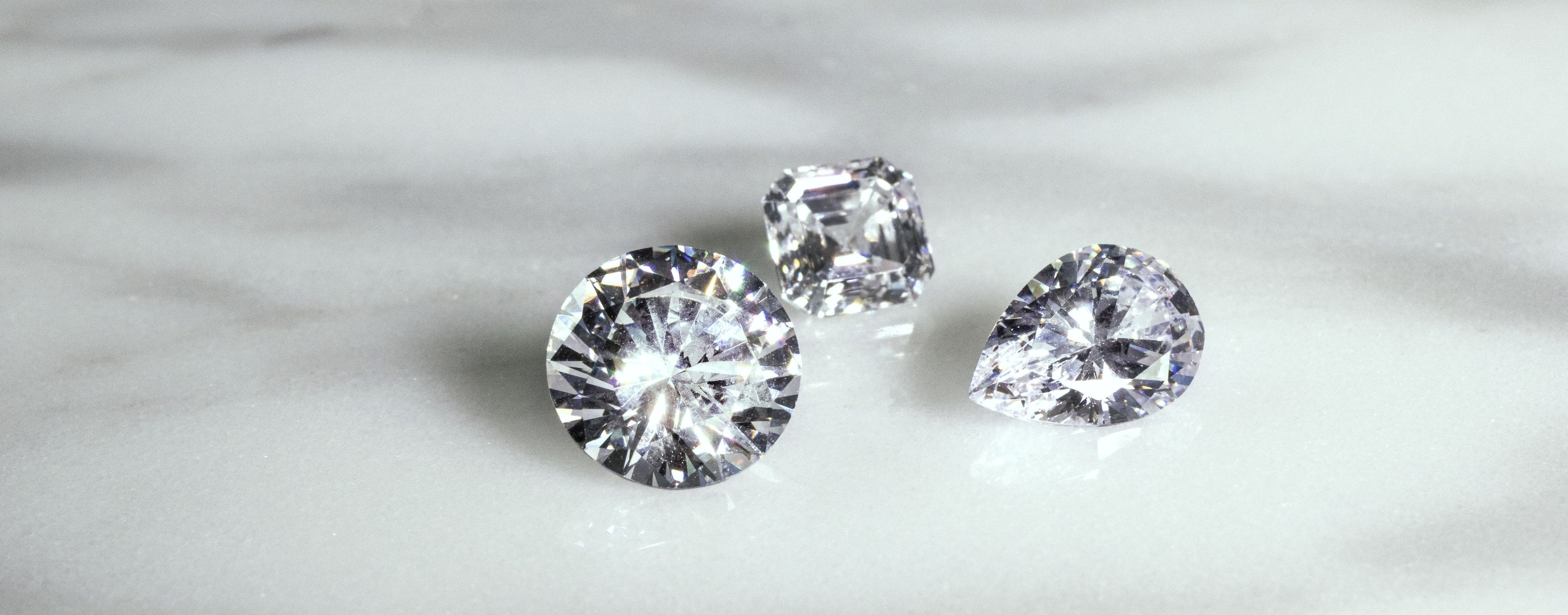
If you are interested in a lab-created diamond ring, you’re not alone. These manmade stones are becoming increasingly sought-after for engagement rings and fine jewelry. More people own lab-grown diamond rings than you think – it's impossible to tell apart a natural diamond and a lab-grown diamond when they are placed side by side. Keep reading to learn more about lab-created diamond rings.
What is a lab-created diamond?
Lab-created diamonds, also called lab-grown diamonds or lab-made diamonds, are diamonds that are produced above-ground in a laboratory rather than below ground by the earth. Lab-created diamonds do not need to be mined.
Are lab-created diamonds real?
Yes, lab-created diamonds are real. The only difference between a lab-grown diamond and an earth-grown diamond is its origin. Lab-created diamonds are chemically, physically, and optically identical to natural diamonds.
Do lab-created diamonds test as real?
Yes, your lab-grown diamond will test as real with a diamond tester.
How to buy a lab-created diamond ring
The best way to buy a lab-created diamond ring is by choosing the diamond and setting yourself rather than choosing a preset ring at a big box chain store. This way, you’ll be able to select a high-quality diamond for your ring and you’ll know exactly what you’re paying for.
Choosing a Lab-Grown Diamond
To buy any diamond, whether it was lab-grown or not, you’ll want to acquaint yourself with the 4 Cs. The 4 Cs (Cut, Color, Clarity, and Carat) are the standard way to determine the beauty and value of a diamond.
Cut
Cut is generally considered the most important of the 4 Cs. This is because the beauty of a diamond relies heavily on its cut quality. A well-cut diamond will be full of sparkle; a poorly cut diamond will look dull and won’t sparkle very much. Cut is also important for visual size – a poorly cut diamond will look smaller than other diamonds of the same carat weight. To ensure your lab-grown diamond is well-cut, choose an Ideal cut for round-cut diamonds or a Very Good cut for fancy shapes.
Color
Color actually measures how little color a diamond reflects. In general, diamonds that appear colorless (or white) are the most desirable. Diamonds are graded on a scale from D to Z – D-color diamonds being completely colorless, Z-color diamonds having a noticeable brown or yellow color.
At Ritani, we recommend near-colorless diamonds since they are beautiful and more affordable. Near-colorless diamonds such as G or H diamonds will appear colorless, but cost far less than D, E, or F color diamonds, which are extremely rare and therefore more valuable.
Clarity
Most diamonds have inclusions or tiny imperfections inside of them. These inclusions are the result of the high pressures and temperatures that diamonds undergo when they are being formed. In fact, a diamond that does not have inclusions is a big indicator that the stone is a stimulant and not a real diamond. Stones like cubic zirconia do not have any inclusions.
Lab-grown diamonds can still have inclusions, too, even though they are not formed under the earth’s surface.
While many inclusions aren’t noticeable to the naked eye, too many inclusions will put a damper on the diamond’s beauty.
At Ritani, we recommend a minimum clarity grade of VS2 or better to ensure an eye-clean diamond.
Carat
Carat is the measure of how much a diamond weighs. One carat is equivalent to 0.2 grams or 200 milligrams. Carat can also correlate to how large the diamond looks.
Not all diamonds that are the same carat weight will appear to be the same size. This is influenced by diamond shape and cut quality.
Fancy shapes like oval-cut diamonds, marquise-cut diamonds, and pear-cut diamonds will appear larger than other stones of the same carat weight since they have a large surface area. Shapes like the Asscher-cut and cushion-cut will appear smaller than stones of the same carat weight since most of their weight is carried in the bottom of the stone rather than the upper half.
The average diamond engagement ring in the U.S. is about 1-carat.
Choosing a Setting
The setting is the piece of metal that holds your diamond. There are many different setting styles and precious metals to suit your tastes and needs.
Precious Metals
These are the most popular precious metals used for diamond rings.
White Gold
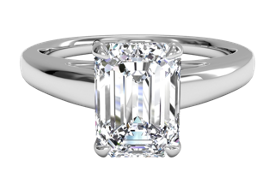
This cool-toned, silvery metal is the most popular metal purchased by Ritani shoppers. It looks like platinum but is much more affordable. The main caveat with white gold is that it will need to be replated with rhodium over time – learn more about that here.
At Ritani, white gold engagement ring settings are available in 14kt white gold and 18kt white gold. 14kt white gold is more common as it is less expensive. 18kt costs a bit more since it has more gold content.
Yellow Gold
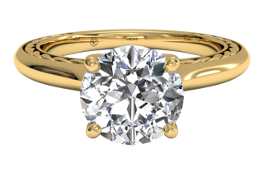
This classic, warm-toned metal has been a favorite for centuries. At Ritani, we offer 18kt yellow gold rings, which are 75% pure gold. 18kt yellow gold is the most hypoallergenic out of all the gold varieties.
Rose Gold
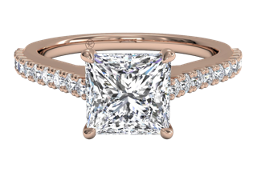
While rose gold is not a new creation, it has recently been incredibly in demand. This romantic metal is perfect for someone who is looking for a unique engagement ring. Keep in mind that since rose gold gets its color from copper, it's not hypoallergenic.
Platinum
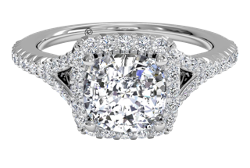
If you’re looking for a hypoallergenic metal, choose platinum. Platinum is a strong and heavy metal, so it will last for a lifetime. Since it is very rare, it is much more expensive than gold. It doesn’t require extra maintenance as white gold will.
Setting Styles
Here are the most common setting styles for diamond rings. Choose whichever one appeals to you – there is no right or wrong setting!
Solitaire Settings
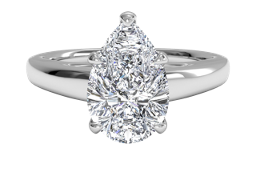
Solitaire diamond rings feature a single diamond set in the band. This simple yet elegant style is a great choice for someone with an active lifestyle as there are no diamond accents to accidentally knock loose. Solitaire settings are typically the most affordable settings since they do not feature any extra embellishments.
Sidestone Settings
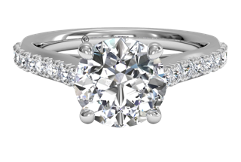
Sidestone diamond rings feature tiny diamonds set in the band for a sophisticated and glamorous look. The extra diamonds will add even more sparkle to your ring.
Halo Settings
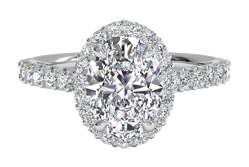
Halo diamond rings feature tiny diamonds surrounding your center stone. This creates the illusion of a larger diamond while also giving your ring additional sparkle. Halo settings work with any diamond shape but are especially desirable for someone who wants an Asscher-cut or emerald-cut diamond since these diamond shapes don’t sparkle much on their own. Halos are also beneficial for diamonds with sharp edges, like the pear-cut or marquise-cut because they can protect their sharp edges from damage.
Three-Stone Settings
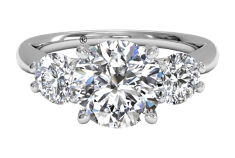
Three-stone settings feature three diamonds set into the band. These three diamonds don’t have to match; for example, you could have a princess-cut diamond center stone with round-cut diamond side stones. Some other popular diamond cuts for three-stone rings include baguette-cut diamonds and pear-cut diamonds. Three-stone rings are said to represent your past, present, and future together as a couple.
Vintage-Inspired Settings
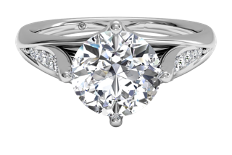
Vintage-inspired settings incorporate unique, ornate designs and old-world charm. Since they feature more elaborate designs, they are sometimes more expensive than other setting styles.
Final Thoughts
A lab-grown diamond is a beautiful choice for your ring. With the same sparkle and brilliance as natural diamonds, no one will know the difference. Should you need help choosing the right diamond, our non-commissioned gemologists are available every step of the way – contact us to get started.


